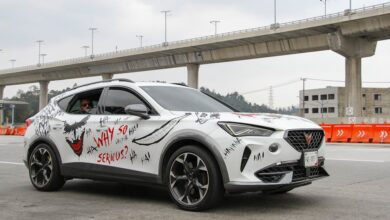The Electric Dream Meets Reality: A Tough Road for Innovation

Remember the fanfare? The images of President Biden getting behind the wheel, the pre-orders stacking up, the promise of an electric pickup truck that could power your home? The Ford F-150 Lightning burst onto the scene with an almost palpable sense of excitement, symbolizing not just a new vehicle, but a bold statement about the future of America’s best-selling truck and Ford’s commitment to electrification. It was, for many, the moment the electric revolution felt truly tangible, arriving in a package as iconic as the F-150 itself.
Fast forward just three years, and that bright future seems to be dimming. Recent reports suggest that Ford executives are now actively discussing the unthinkable: ending production of the F-150 Lightning. This news, following a production pause to prioritize gas and hybrid versions of the F-150, sends ripples far beyond Dearborn, raising crucial questions about the pace of EV adoption, the challenges of innovation, and the delicate dance between market demand and corporate ambition. What went wrong, and what does this potential pivot mean for Ford and the wider electric vehicle landscape?
The Electric Dream Meets Reality: A Tough Road for Innovation
Ford’s foray into electric vehicles, especially with the F-150 Lightning, wasn’t just about launching a new model; it was about transforming an icon. The F-Series trucks have been the backbone of Ford’s profitability for decades, and electrifying that cash cow was a monumental gamble. On paper, it made perfect sense: combine America’s favorite vehicle with the burgeoning EV trend. The initial reception seemed to confirm this vision.
However, the journey from concept to mass market success is often paved with unexpected hurdles. While early adopters embraced the Lightning with enthusiasm, the broader market has proven to be a tougher nut to crack. The realities of charging infrastructure, range anxiety, higher purchase prices, and the sheer inertia of traditional truck buyers have created a headwind that even the mighty F-150 brand is struggling to overcome.
It’s a classic innovator’s dilemma: you build it, but will they come in the numbers needed to sustain it? For Ford, the investment in its EV segment has been massive, and the path to profitability has been slower and more challenging than initially projected. This isn’t just a Ford problem; it’s a sobering reminder that even with significant investment and a strong brand, the transition to EVs is complex and fraught with uncertainties.
Decoding the Lightning’s Challenges: Why the Sudden Pause?
The decision to reportedly discuss ending the F-150 Lightning isn’t made lightly. It’s a strategic move likely driven by a confluence of factors that have made the electric pickup a less viable proposition than initially hoped. The production pause earlier this year, ostensibly to retool and improve quality, was perhaps an early indicator of deeper issues.
Market Demand vs. Production Capacity
One of the primary challenges has been the slower-than-anticipated ramp-up in demand for electric pickups, especially outside of early adopter segments. While Ford initially had a strong backlog of reservations, converting those into actual sales at a profitable margin has proven difficult. Building trucks is expensive, and if sales aren’t meeting targets, it quickly erodes margins and ties up capital that could be used elsewhere.
Traditional F-150 owners often rely on their trucks for heavy-duty work, long hauls, and rural commutes where charging infrastructure is sparse. The electric Lightning, while powerful, still faces limitations in towing range and charging times that can make it a less practical choice for these core users compared to a gasoline or hybrid counterpart.
Profitability Pressures and Competitive Landscape
The cost of producing electric vehicles, particularly large battery packs, remains high. Achieving profitability on EVs, especially with the downward pressure on pricing, has been a significant hurdle for many automakers. The F-150 Lightning, despite its premium pricing, may not be generating the kind of margins Ford needs to justify its continued existence, particularly when benchmarked against its highly profitable gas and hybrid siblings.
Moreover, the competition in the electric pickup segment is heating up, albeit slowly. Rivian’s R1T, while niche, offers a compelling package, and Tesla’s polarizing Cybertruck is finally hitting the roads. The landscape is becoming more crowded, making it harder for any single player to dominate, especially if they are struggling with cost and demand.
The Broader Implications for Ford and the EV Market
If Ford does pull the plug on the F-150 Lightning, it would be a watershed moment for the automotive industry. It signals a potential recalibration of EV strategies across the board, moving away from an ‘electrify everything’ mentality to a more measured, market-driven approach.
For Ford, this likely means a renewed focus on hybrid technology, which offers a bridge solution for many consumers. Hybrids provide improved fuel economy without the range anxiety or charging infrastructure demands of full EVs. Ford’s recent prioritization of hybrid and gasoline F-150 production is a clear indicator of this shift, acknowledging that the mainstream market isn’t quite ready for a full electric leap for its workhorse vehicles.
This pivot isn’t necessarily a failure of electrification but a recognition of market realities. Ford is a business, and businesses need to adapt to consumer preferences and economic conditions. It’s about optimizing resources where they can make the biggest impact and generate the most profit. It also suggests that the timeline for mass EV adoption might be longer and more uneven than initially predicted by some industry cheerleaders.
What’s Next for the Electric Pickup?
Does this mean the end of electric pickups? Absolutely not. The F-150 Lightning’s potential demise would be a data point, a learning experience, rather than a definitive statement on the entire segment. It highlights the importance of getting the product, price, and infrastructure right. Other manufacturers, having observed Ford’s journey, will undoubtedly adjust their own strategies.
Perhaps future electric pickups will need to be smaller, more affordable, or offer vastly improved battery technology and charging speeds to truly win over the masses. Or maybe, like the internal combustion engine before it, the electric pickup will find its niche and slowly, steadily grow over decades rather than years. Ford itself might even revisit an electric pickup concept in the future, armed with new insights and technologies.
The F-150 Lightning was an ambitious and courageous move by Ford, pushing the boundaries of what was possible for an electric truck. Its potential winding down isn’t just a corporate decision; it’s a stark reminder that even the most innovative ideas must contend with the realities of market demand, infrastructure, and profitability. While the dream of an all-electric F-150 powering every home might be on pause, the broader journey towards an electrified future continues, albeit with a renewed sense of caution and a deeper appreciation for the complex road ahead. It’s a testament to the dynamic nature of the auto industry, where even giants must constantly adapt, learn, and evolve.





